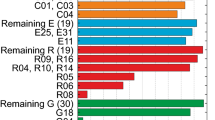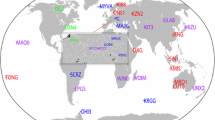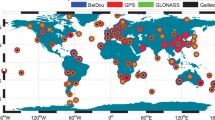Abstract
In this contribution, we present a GPS+GLONASS+BeiDou+Galileo four-system model to fully exploit the observations of all these four navigation satellite systems for real-time precise orbit determination, clock estimation and positioning. A rigorous multi-GNSS analysis is performed to achieve the best possible consistency by processing the observations from different GNSS together in one common parameter estimation procedure. Meanwhile, an efficient multi-GNSS real-time precise positioning service system is designed and demonstrated by using the multi-GNSS Experiment, BeiDou Experimental Tracking Network, and International GNSS Service networks including stations all over the world. The statistical analysis of the 6-h predicted orbits show that the radial and cross root mean square (RMS) values are smaller than 10 cm for BeiDou and Galileo, and smaller than 5 cm for both GLONASS and GPS satellites, respectively. The RMS values of the clock differences between real-time and batch-processed solutions for GPS satellites are about 0.10 ns, while the RMS values for BeiDou, Galileo and GLONASS are 0.13, 0.13 and 0.14 ns, respectively. The addition of the BeiDou, Galileo and GLONASS systems to the standard GPS-only processing, reduces the convergence time almost by 70 %, while the positioning accuracy is improved by about 25 %. Some outliers in the GPS-only solutions vanish when multi-GNSS observations are processed simultaneous. The availability and reliability of GPS precise positioning decrease dramatically as the elevation cutoff increases. However, the accuracy of multi-GNSS precise point positioning (PPP) is hardly decreased and few centimeter are still achievable in the horizontal components even with 40\(^{\circ }\) elevation cutoff. At 30\(^{\circ }\) and 40\(^{\circ }\) elevation cutoffs, the availability rates of GPS-only solution drop significantly to only around 70 and 40 %, respectively. However, multi-GNSS PPP can provide precise position estimates continuously (availability rate is more than 99.5 %) even up to 40\(^{\circ }\) elevation cutoff (e.g., in urban canyons).















Similar content being viewed by others
References
Al-Shaery A, Zhang S, Rizos C (2013) An enhanced calibration method of GLONASS inter-channel bias for GNSS RTK. GPS Solut 17(2):165–173. doi:10.1007/s10291-012-0269-5
Altamimi Z, Collilieux X, Métivier L (2011) ITRF2008: an improved solution of the international terrestrial reference frame. J Geod 85(8):457–473. doi:10.1007/s00190-011-0444-4
Cai C, Gao Y (2013) Modeling and assessment of combined GPS/GLONASS precise point positioning. GPS Solut 17(2):223–236
Caissy M, Agrotis L, Weber G, Hernandez-Pajares M, Hugentobler U (2012) Coming Soon: the international GNSS real-time service. In: Proceedings of GPS world, vol 23, issue 6, pp 52–58
Chen X, Landau H, Zhang F, Nitschke M, Glocker M, Kipka A, Weinbach U, Salazar D (2013) Towards a precise multi-GNSS positioning system enhanced for the Asia-Pacific region. In: Proceedings of lecture notes in electrical engineering, China Satellite Navigation Conference (CSNC), vol 245, pp 277–290
China Satellite Navigation Office (CSNO) (2012) BeiDou Navigation Satellite System Signal in Space Interface Control Document. http://gge.unb.ca/test/beidou_icd_english.pdf
Dach R, Schaer S, Hugentobler U (2006) Combined multi-system GNSS analysis for time and frequency transfer. Proc Eur Freq Time Forum 2006:530–537
Dow JM, Neilan RE, Rizos C (2009) The international GNSS service in a changing landscape of global navigation satellite systems. J Geod 83:191–198. doi:10.1007/s00190-008-0300-3
Ge M, Gendt G, Rothacher M, Shi C, Liu J (2008) Resolution of GPS carrier-phase ambiguities in precise point positioning (PPP) with daily observations. J Geod 82(7):389–399. doi:10.1007/s00190-007-0187-4
Ge M, Zhang HP, Jia XL, Song SL, Wickert J (2012) What Is achievable with the current COMPASS constellation? GPS World pp 29–34
Hauschild A, Montenbruck O, Sleewaegen JM, Huisman L, Teunissen PJG (2012) Characterization of compass M-1 signals. GPS Solut 16:117–126
He H, Li J, Yang Y, Xu J, Guo H, Wang A (2013a) Performance assessment of single- and dual-frequency BeiDou/GPS single-epoch kinematic positioning. GPS Solut 18(3):393–403
He L, Ge M, Wang J, Wickert J, Schuh H (2013b) Experimental study on the precise orbit determination of the BeiDou navigation satellite system. Sensors 13(3):2911–2928. doi:10.3390/s130302911
Kouba J (2009) A guide to using international GNSS service (IGS) products. http://igscb.jpl.nasa.gov/igscb/resource/pubs/UsingIGSProductsVer21.pdf
Li X, Zhang X, Ge M (2011) Regional reference network augmented precise point positioning for instantaneous ambiguity resolution. J Geod 85:151–158
Li X, Ge M, Zhang H, Nischan T, Wickert J (2013a) The GFZ real-time GNSS precise positioning service system and its adaption for COMPASS. Adv Space Res 51(6):1008–1018
Li X, Ge M, Zhang H, Wickert J (2013b) A method for improving uncalibrated phase delay estimation and ambiguity-fixing in real-time precise point positioning. J Geod 87(5):405–416. doi:10.1007/s00190-013-0611-x
Li X, Ge M, Zhang X, Zhang Y, Guo B, Wang R, Klotz J, Wickert J (2013c) Real-time high-rate co-seismic displacement from ambiguity-fixed precise point positioning: application to earthquake early warning. Geophys Res Lett 40(2):295–300. doi:10.1002/grl.50138
Li X, Dick G, Ge M, Heise S, Wickert J, Bender M (2014) Real-time GPS sensing of atmospheric water vapor: precise point positioning with orbit, clock, and phase delay corrections. Geophys Res Lett 41(10):3615–3621. doi:10.1002/2013GL058721
Li X, Zhang X, Ren X, Fritsche M, Wickert J, Schuh H (2015) Precise positioning with current multi-constellation global navigation satellite systems: GPS, GLONASS. Galileo and BeiDou Sci Rep 5:8328
Liu J, Ge M (2003) PANDA software and its preliminary result of positioning and orbit determination. Wuhan Univ J Nat Sci 8:603–609
McCarthy D, Petit G (2003) IERS conventions, IERS technical note no. 32, Publisher of the Federal Agency for Cartography and Geodesy: Frankfurt am Main, Germany
Montenbruck O, Hauschild A, Steigenberger P, Hugentobler U, Teunissen P, Nakamura S (2012) Initial assessment of the COMPASS/BeiDou-2 regional navigation satellite system. GPS Solut 17(2):211–222. doi:10.1007/s10291-012-0272-x
Montenbruck O, Steigenberger P, Khachikyan R, Weber G, Langley RB, Mervart L, Hugentobler U (2014) IGS-MGEX: preparing the ground for multi-constellation GNSS science. Inside GNSS 9(1):42–49
Odijk D, Teunissen PJG (2013) Characterization of between-receiver GPS-Galileo inter-system biases and their effect on mixed ambiguity resolution. GPS Solut 17(4):521–533. doi:10.1007/s10291-012-0298-0
Schaer S, Beutler G, Rothacher M, Brockmann E, Wiger A, Wild U (1999) The impact of the atmosphere and other systematic errors on permanent GPS networks. In: Proceedings of President IAG symposium on positioning, Birmingham, UK, 19–24 July, p 406
Schaffrin B, Bock Y (1988) A unified scheme for processing GPS dual-band phase observations. Bull Geod 62:142–160
Shi C, Zhao Q, Li M, Tang W, Hu Z, Lou Y, Zhang H, Niu X, Liu J (2012) Precise orbit determination of BeiDou satellites with precise positioning. Sci China Earth Sci 55:1079–1086
Steigenberger P, Hugentobler U, Montenbruck O, Hauschild A (2011) Precise orbit determination of GIOVE-B based on the CONGO network. J Geod 85:357–365
Teunissen PJG, Odolinski R, Odijk D (2014) Instantaneous BeiDou+GPS RTK positioning with high cut-off elevation angles. J Geod 88(4):335–350. doi:10.1007/s00190-013-0686-4
Yang YX, Li JL, Xu JY, Tang J, Guo HR, He HB (2011) Contribution of the compass satellite nagivation system to global PNT users. Chin Sci Bull 56(26):2813–2819. doi:10.1007/s11434-001-4627-4
Zhang X, Li X, Guo F (2011) Satellite clock estimation at 1 Hz for realtime kinematic PPP applications. GPS Solut 15(4):315–324. doi:10.1007/s10291-010-0191-7
Zhao Q, Guo J, Li M, Qu L, Hu Z, Shi C, Liu J (2013) Initial results of precise orbit and clock determination for COMPASS navigation satellite system. J Geod 2013(5):475–486
Zumberge JF, Heflin MB, Jefferson DC, Watkins MM, Webb FH (1997) Precise point positioning for the efficient and robust analysis of GPS data from large networks. J Geophys Res 102(B3):5005–5017. doi:10.1029/96JB03860
Acknowledgments
We are very grateful to IGS, MGEX, WHU and HuBei CORS for providing multi-GNSS data.
Author information
Authors and Affiliations
Corresponding author
Appendices
Appendix A
Figure 16 shows the kinematic PPP results for another four-system station GMSD, which is located in Japan. The PPP solutions related to GPS, GLONASS and BeiDou have similar performance compared to the results of CUT0 station. As shown in Fig. 16d, Galileo-only PPP is achievable for few hours even with four satellites. The accuracy of several centimeters can be obtained for about 2–3 h, although currently it is not possible to use Galileo as a stand-alone system for continuous positioning. Meanwhile, as shown in Fig. 16h, Galileo also provides a contribution to some extent for PPP solutions when used together with, e.g., GPS. The sky plots (azimuth vs. elevation) of four systems for GMSD are shown in Fig. 17.
Figure 18 shows the kinematic PPP results for another four-system station LMMF located in Latin America with latitude of –14.59\(^{\circ }\) and longitude of –60.99\(^{\circ }\). At this location, both Beidou and Galileo cannot provide continuous positioning as a stand-alone system and only few hours of Beidou-only and Galileo-only PPP are obtainable, as shown in Fig. 18c, d. However, the PPP solutions can converges faster and achieve more accurate position series when Beidou or Galileo are combined together with GPS, as demonstrated in Fig. 18g, h.
The PPP accuracy with different observational lengths (e.g., 0.25, 0.5, 1, and 2 h) is compared in Fig. 19. The accuracy of single-system PPP is improved along with the observational lengths. If data of 2 h or longer are involved in the processing, position accuracy of few centimeters can be achieved. For multi-GNSS PPP, the accuracy of few centimeters is already available in all the three components with observational length of 0.25 h and then stays on cm-level.
Appendix B
Figure 20 shows the PPP results, satellite numbers, and PDOP values under different elevation cutoffs for another four-system station GMSD. It has similar performance as the station CUT0: PDOP gets larger as the elevation cutoff gets larger. The availability and reliability of GPS precise positioning decrease dramatically as the elevation cutoff increases. Importantly though, the PDOP of the multi-GNSS remains small for large elevation cutoffs. Furthermore, the positioning accuracy of multi-PPP is nearly not decreased and few centimeters are still achievable in horizontal components even with 40\(^{\circ }\) elevation cutoff. The vertical accuracy decreases gradually as the elevation cutoff increases.
We also present the PPP results under different elevation cutoffs for the dual-system station CENT in Fig. 21. With elevation cutoff of 20\(^{\circ }\), there is a obvious spike in the north components of GPS PPP due to the reduction of observable satellites to only four, while GPS+BeiDou PPP does not present any decrease in accuracy. When the elevation cutoff is increased to 30\(^{\circ }\) or 40\(^{\circ }\), reliable GPS PPP is not achievable. The position series of combined PPP are only a little nosier for 30\(^{\circ }\) elevation cutoff. They are much nosier at 40\(^{\circ }\), but the accuracy of centimeter lever can still be obtained in horizontal components. Compared with the Fig. 20, although the dual-system PPP solutions are not as stable and robust as the four-system PPP, the convergence time, PNT accuracy and reliability benefits from adding BeiDou.
Rights and permissions
About this article
Cite this article
Li, X., Ge, M., Dai, X. et al. Accuracy and reliability of multi-GNSS real-time precise positioning: GPS, GLONASS, BeiDou, and Galileo. J Geod 89, 607–635 (2015). https://doi.org/10.1007/s00190-015-0802-8
Received:
Accepted:
Published:
Issue Date:
DOI: https://doi.org/10.1007/s00190-015-0802-8










